(word完整版)人教版七年级上册unit4英语说课稿
- 格式:doc
- 大小:32.01 KB
- 文档页数:4
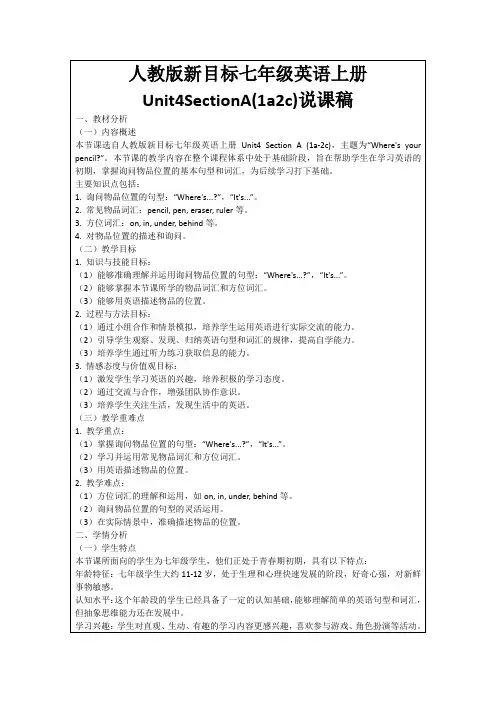
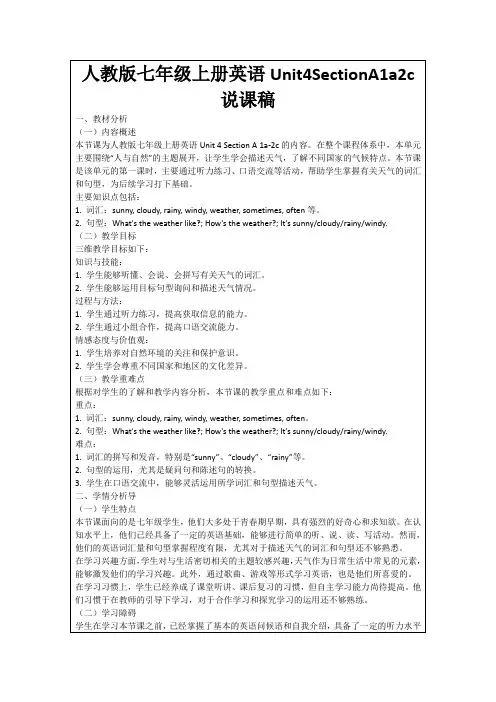

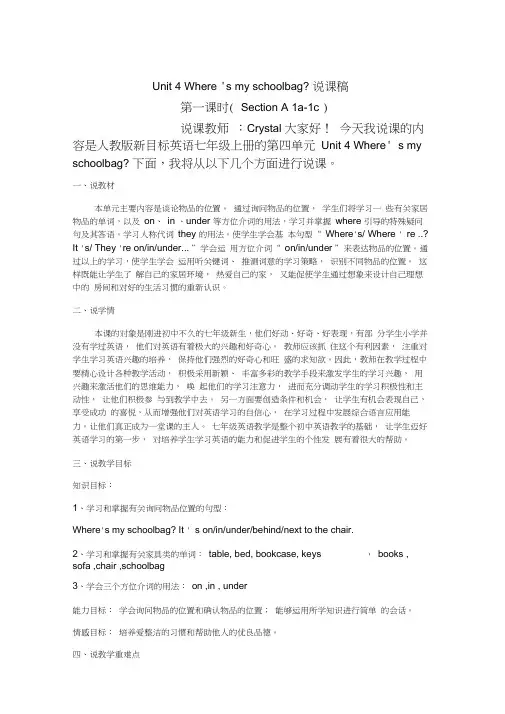
Unit 4 Where 's my schoolbag? 说课稿第一课时( Section A 1a-1c )说课教师:Crystal 大家好!今天我说课的内容是人教版新目标英语七年级上册的第四单元Unit 4 Where' s my schoolbag? 下面,我将从以下几个方面进行说课。
一、说教材本单元主要内容是谈论物品的位置。
通过询问物品的位置,学生们将学习一些有关家居物品的单词,以及on、in 、under 等方位介词的用法,学习并掌握where 引导的特殊疑问句及其答语。
学习人称代词they 的用法。
使学生学会基本句型“ Where's/ Where ' re ..? It 's/ They 're on/in/under... ”学会运用方位介词“ on/in/under ”来表达物品的位置。
通过以上的学习,使学生学会运用听关键词、推测词意的学习策略,识别不同物品的位置。
这样既能让学生了解自己的家居环境,热爱自己的家,又能促使学生通过想象来设计自己理想中的房间和对好的生活习惯的重新认识。
二、说学情本课的对象是刚进初中不久的七年级新生,他们好动、好奇、好表现,有部分学生小学并没有学过英语,他们对英语有着极大的兴趣和好奇心。
教师应该抓住这个有利因素,注重对学生学习英语兴趣的培养,保持他们强烈的好奇心和旺盛的求知欲。
因此,教师在教学过程中要精心设计各种教学活动,积极采用新颖、丰富多彩的教学手段来激发学生的学习兴趣,用兴趣来激活他们的思维能力,唤起他们的学习注意力,进而充分调动学生的学习积极性和主动性,让他们积极参与到教学中去。
另一方面要创造条件和机会,让学生有机会表现自己,享受成功的喜悦,从而增强他们对英语学习的自信心,在学习过程中发展综合语言应用能力。
让他们真正成为一堂课的主人。
七年级英语教学是整个初中英语教学的基础,让学生迈好英语学习的第一步,对培养学生学习英语的能力和促进学生的个性发展有着很大的帮助。
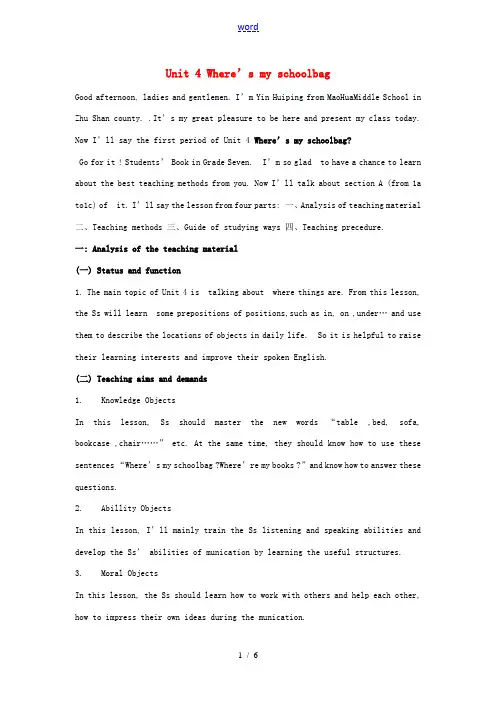
Unit 4 Where’s my schoolbagGood afternoon, ladies and gentlemen. I’m Yin Huiping from MaoHuaMiddle School in Zhu Shan county. .It’s my great pleasure to be here and present my class today. Now I’ll say the first period of Unit 4 Where’s my schoolbag?Go for it ! Students’Book in Grade Seven. I’m so glad to have a chance to learn about the best teaching methods from you. Now I’ll talk about section A (from 1a to1c) of it. I’ll say the lesson from four parts: 一、Analysis of teaching material 二、Teaching methods 三、Guide of studying ways 四、Teaching precedure.一: Analysis of the teaching material(一) Status and function1. The main topic of Unit 4 is talking about where things are. From this lesson, the Ss will learn some prepositions of positions,such as in, on ,under… and use them to describe the locations of objects in daily life. So it is helpful to raise their learning interests and improve their spoken English.(二) Teaching aims and demands1. Knowledge ObjectsIn this lesson, Ss should master the new words “table ,bed, sofa, bookcase ,chair……” etc. At the same time, they should know how to use these sentences “Where’s my schoolbag ?Where’re my books ?”and know how to answer these questions.2. Abillity ObjectsIn this lesson, I’ll mainly train t he Ss listening and speaking abilities and develop the Ss’ abilities of munication by learning the useful structures.3. Moral ObjectsIn this lesson, the Ss should learn how to work with others and help each other, how to impress their own ideas during the munication.4.Teaching keys and difficultiesAccording to the teaching aims, I think the focus of this lesson is the use of new expressions“in,, on , under… ” and help the Ss to municate with each other. The difficulty is to master the Where questions.二、Teaching methodsAs we all know: the main instructional aims of learning English in middle school is to bring upstudents’basic abilities of listening、speaking、reading and writing and their good sense of the English language. So In this lesson, I’ll mainl y use the “task-based” teaching method, and it will be used in the whole lesson. That is to say, I will let the Ss learn in real situations, finish tasks and some activities , guessing games, watching a flash, acting to help the Ss to get a better understanding of the key structure of the conversation .I think it’s helpful to develop the Ss’ thought. I’llalso use “situation municating” method. It can provide enough listening and speaking situations for Ss. I think good teaching methods are the keys to success.三、Guide of studying methodIn order to guide the Ss better, develop the Ss’ abilities, in this lesson, I ‘m not a teacher, but a guider .I’m ready to give them help whenever they need and re-correct the mistakes while talking .Each unit in Go for it contains pair work, group work and games. The students who sit at the same table and groups can make a discussion and learn from each other. It makes each student relaxed. They needn’t worry about making mistakes. It can arouse students to think and to say what they want to say. Study bees more relaxing and pleasing in this kind of environment.Then the Ss will learn how to be a good language learner , and how to municate with others. It will be very helpful for their learning in the future. I think good studying ways can help the Ss to be good language learners.四、Teaching procedure:Step One: Warming up.1. Enjoy “Where’s thumbkin’’ song.In order to form a better Englishsurrounding for Ss, attract the Ss’ attention, I’ll begin my class with an Englishsong—Where is thumbkin ? song. It can help the students to be clear. I think a goodbeginning is a half of success.2. Revise some school things..Play a guessing game by putting some schoolthings in a box to revise them. e.g.: What’s this in Eng lish? How do you spellit? Is this your…?What color is it?3.Say like this:1) Pen-pens pencil-pencils ruler-rulersKey-keys eraser-erasers book-books …2) This is a pen. These are pens.Step Two :Presentation: New words learning.1. 1.Point at a desk and say “ This is a desk.Then teach them to read “ desk,a desk , This is a desk.2. Show the pictures on the screen. Show the pictures first, then the wordsone by one. Read the new words one by one. 1).Show the picture ofa table ,ask: Is it a desk ? Help the Ss answer: No .,it isn’t.It’s a table. Writetable on the blackboard ,teach them to read table ,a table ,It’s a table .Teach‘chair ,sofa ,bookcase ,bed like this. .2). Look at the picture on page 19.Ask them to do 1a of the students’book . Match the words with the things in the picture, and check the answer together.Read the new words on the left by the students.Step Three: Presentation.1. Use real objects to present in, on, under , then show the pictures of differentpositions. Show the pictures of a box and an apple to teach ″in, on, under″2. look at the picture on the screen to present the target language again. .3.Ask some of them to do part 1of the exercise on the blackboard and check the answer together .Finally read .4..Playing a game .Listen and do. Put the book in your desk. Put the pen on your book….Step Four. Practice.1.Guide them to say sentences together according to the pictures of using in,on ,under .2.Add where question . Present ″where’s…?It’s in/on/under…″ with a penciland a book3. Show some pencils andbooks to the students and present ″Where are…? They’re….”4. Ask and answer in pairs.Encourage them to use different words and find out the best group.This activity can not only help the Ss grasp the usage of target language, but alsocan help the Ss learn from each other. It can not only improve the Ss’ speakingand listening skills, but aslo improve their ability of working with others. TheSs at this age enjoy showing themselves, so it can also improve theirstudying interests, I think it’s most important during studying, because interest is a best teacher.Step FiveListening1.Ask students to look at the pictures in activity 1a. Then ask students to readthe sample conversations in activity 1c.2 Listen to the tape, finish 1b with the students.while the Ss listening , I’ll go around the classroom and help the Ss who have troublein listening . It can not only help the Ss who have trouble in listening, but also help the teachers go closer to the Ss. I think the closer the teachers go to the Ss , the better the students will learn.亲其师,信其道。
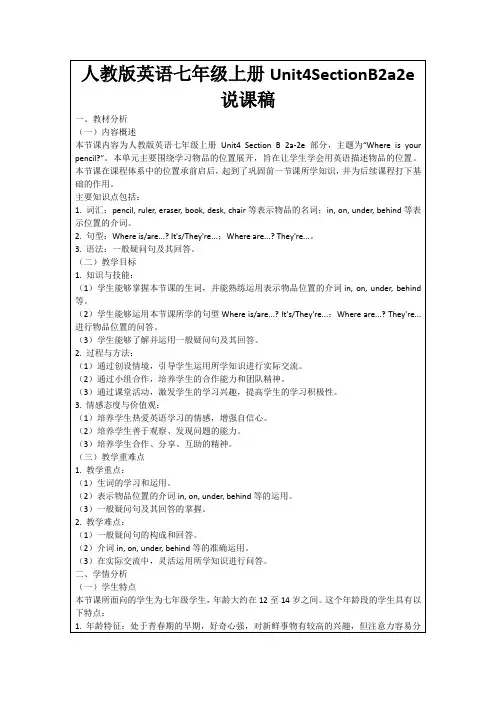
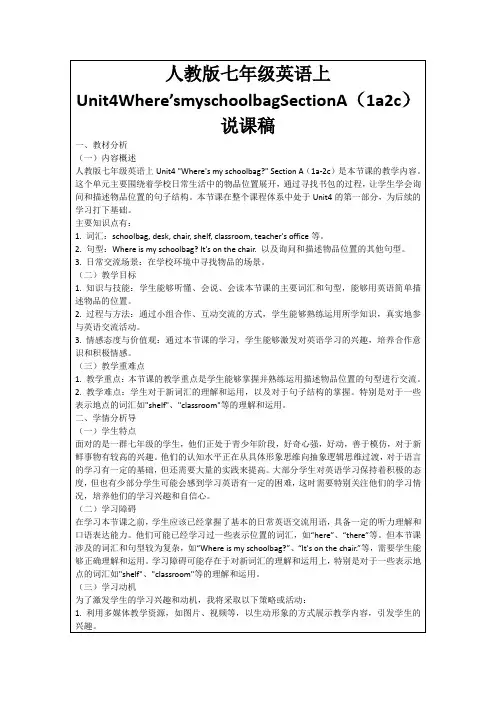
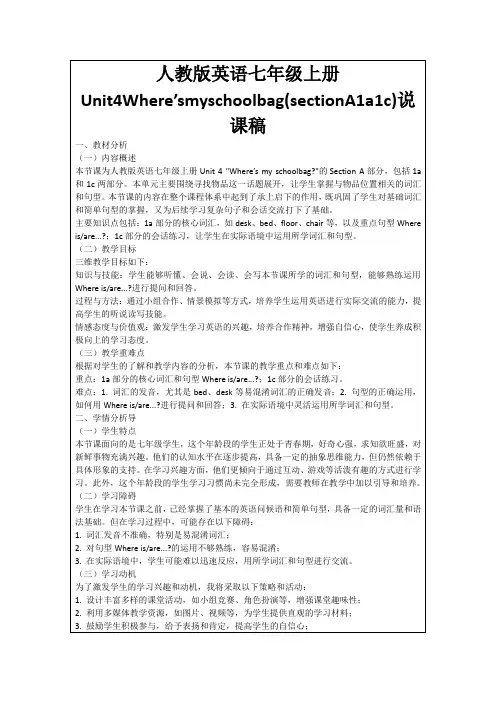
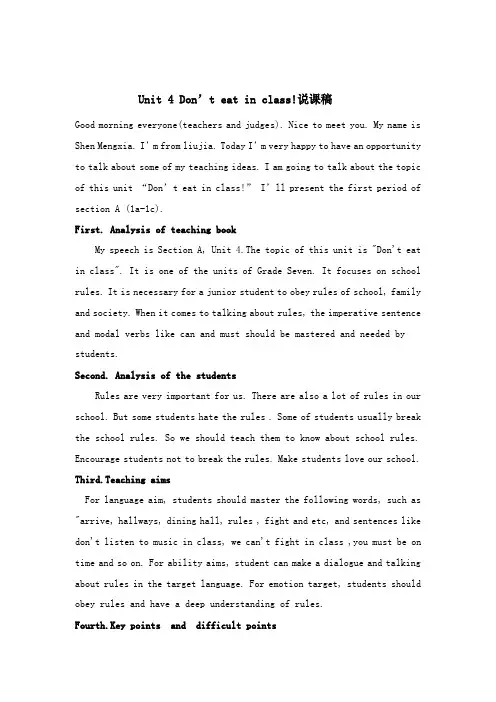
Unit 4 Don’t eat in class!说课稿Good morning everyone(teachers and judges). Nice to meet you. My name is Shen Mengxia. I’m from liujia. Today I’m very happy to have an opportunity to talk about some of my teaching ideas. I am going to talk about the topic of this unit “Don’t eat in class!” I’ll present the first period of section A (1a-1c).First. Analysis of teaching bookMy speech is Section A, Unit 4.The topic of this unit is "Don't eat in class". It is one of the units of Grade Seven. It focuses on school rules. It is necessary for a junior student to obey rules of school, family and society. When it comes to talking about rules, the imperative sentence and modal verbs like can and must should be mastered and needed by students.Second. Analysis of the studentsRules are very important for us. There are also a lot of rules in our school. But some students hate the rules . Some of students usually break the school rules. So we should teach them to know about school rules. Encourage students not to break the rules. Make students love our school. Third.Teaching aimsFor language aim, students should master the following words, such as "arrive, hallways, dining hall, rules , fight and etc, and sentences like don't listen to music in class, we can't fight in class ,you must be on time and so on. For ability aims, student can make a dialogue and talking about rules in the target language. For emotion target, students should obey rules and have a deep understanding of rules.Fourth.Key points and difficult pointsThe key points are the key words and sentences, imperative sentence and modal verb “can, must”.The difficult points: talk about rues in the target language.Fifth.Teaching and learning methodsIn order to inspire their interest of learning English, I will give them more opportunities to speak English and listen to the original English. I’ll use some pictures and some material object, I choose "listening and speaking procedure. Scene teaching method and communicative teaching method. task-based teaching procedure will be also applied. Students work in groups and cooperate with each other. In this process they can improve themselves and learn from each other.Six. Teaching procedureStep1.greetings and talking.I n this step, first, I’ll play a flash song ”If you are happy”, let the students listen and pay attention to the imperative sentences, like clap your hands, stomp your feet, and act, then follow the song. After that ,play a game(Clap your hands! Stamp your feet!)to let everyone act. In this way,they’ll be happy to have this class.Then I’ll ask“What do you think of this song?”“Can we listen to it in class?” I’ll use some things, like food or MP3,I’ll do some things that break the school rules, then, ask the students: What am I doing now ? They’ll say:”you are eating …and so on. I can ask: Am I right? Can I eat in the classroom? Can I listen to music in class? Now, they’ll discuss the questions , So I can let them know some sentences about the rules.Talking like this:T: Do you like apples ? S: Yes, I do.T: Can we eat apples in class ? S: No, we can't.T: Can we eat hamburgers in class ? Can we eat bananas in class ? S: No, we can't.T: So don't eat in class and why can't we eat in class?(Write "Don't eat in class."on the blackboard.)S: (teacher helps student say)because it's a school rule.(Teach the new word"rule")T: we can't break school rules.(teacher teaches "rules and break rules " in this way)Step2. Presentation .1. Draw a picture that a student break the rules, let them discuss. Then put some pictures that the students break the rules, use some things that they know, then ask and answer questions to introduce the topic.2. Lead them to talk about the people and the rules in the pictures. If they have some questions , I can give some help.T: Now look at the picture. What is she doing ?S: She is listening to music.T: Can we listen to music in class ?S: No, we can't.T: So don't listen to music in class.(Write "Don't listen to music in class." on the blackboard)T: where is it ?S: It's in the hallway.T: What is he doing ?S: He is running.T: Can we run in the hallways? (Teach the new word "hallways")S: No, we can'tT: So don't run in the hallways.(Write "Don't run in the hallways"on the blackboard)Then present knowledge in the same way.3.Check their discussions, show and teach the new words, then write the number of the rule next to the student in 1a.Step3. listening.In this step, I’ll let them guess first, this is a skill in listening. Then listen and write the numbers after the names.Check the answers like this:--What rules is Peter/Amy/Mike breaking?--The second one , don’t run in the hallways.Step4. Task.Ask the students to make a similar dialogue, role-play. It can make the students reach a better understanding of the lesson by making the class lively and interesting.Two forms :1. --What are the rules? Can we arrive late for class?—No, we can't. We can't arrive late for class.--...2. Suppose you're a new teacher, you have to make rules for your class.There are some students break the rules, talk to them.Example.......School rulesDon't eat in class. Don't talk in class.We can't listen to music in the class.Step5. exercise1. ______ arrive late for class/school.2. Don’t eat _________.3. ______ run in the ___________.4. ______ __________ music in the classrooms /hallways.Step 7 Homework(1) Copy the new words and the sentences they learnt today.(2) To sum up our school rules, use "can, can't and don't".(3) To find out some signs around us and try to draw them out.(4) Ask students to prepare the next lesson.Seventh. Blackboard DesignUnit 12 Don’t eat in classSchool rules1. Don't eat in class. rule listen to2. Don't listen to music in class. fight hallway3. Don’t run in the hallways. arrive4.Don’t arrive late for class.5.Don’t listen to music in the classrooms.6.Don’t fight.I write these words and phrases on the blackboard in order to tellthe students that they are very important .I think my blackboard designwill help students understand the lesson better.Eighth . Teaching reflection .The teaching procedure pay attention to the students’interest. Happyteaching ,happy leaning, let the students master knowledge well and getmore skills easily .Students works in groups and cooperate with eachother,they can improve themselves.Ninth . Bright points1.I use a flash song that the students are interested in, at the same time,we learn the imperative sentences easily. That’s learning by doing.2.I draw some pictures ,let them pay attention to the class.3.I use some food that the students like, such as apples, oranges. That's all! Thank you!。
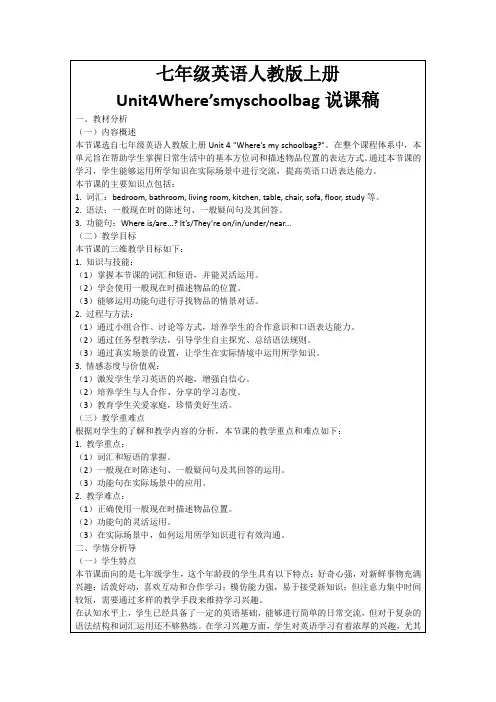
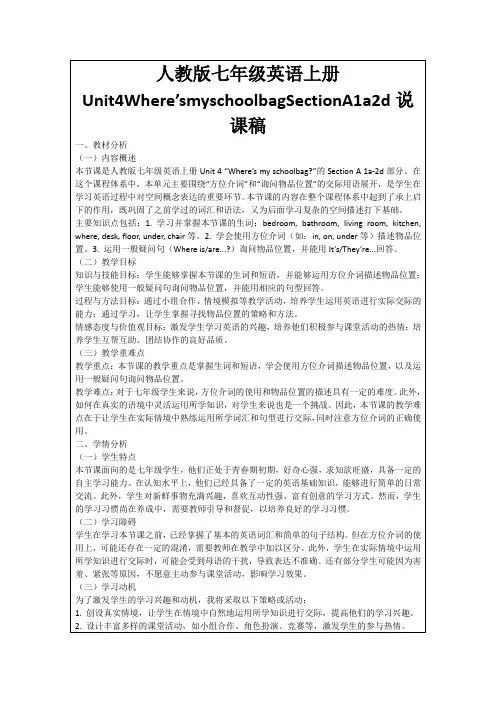
Unit 4 Where’s my backpack一、说教材(一)、教材分析本课是人教版新目标英语七年级上册第四单元的第一节课时。
本单元的话题是谈论物品的位置。
通过单元学习,要求学生在掌握物品名称的基础上用方位介词熟练地表达物品的位置,并能对where问句进行提问并回答。
本课SectionA分为两部分,第一部分主要围绕物品名称及位置进行思维(1a)、听力(1b)、会话(1c)三方面对Where’s / Where are…?句型进行训练。
第二部分是通过谈论位置展开听力(2a—2b)、会话(2c)训练。
我根据教材特点,将一些内容进行整合,把1b、2a 和2b合起来训练学生的听力,1c和2c合起来训练学生的口头表达能力,让学生系统地学好本课的目标语言。
(二)、教学目标根据英语新课标,教材大纲的要求和学情(学生对感兴趣的话题较愿意表达)确立教学目标如下:1、知识目标(1)、掌握本课的重点词汇。
chair, sofa, table,bed,dresser,drawer,plant,bookcase, where under, on, they.(2)、掌握并灵活运用重点句型。
Where’s the backpack? It’s under the table.Where are the books? They are on the sofa.(3)、掌握方位介词in , on , under的用法。
2、能力目标(1)、学会描述物品的位置,并能就物品位置进行提问和回答。
(2)、能对方位介词in,on,under加以灵活运用。
(3)、培养学生的语言运用能力和绘画能力。
3、情感目标培养学生学习英语的兴趣,乐于参与课堂活动的积极情感。
(三)、教学重点和难点根据本课在教材中所处的地位和作用,我确立本课的重难点如下:1、重点:学习掌握用Where’s /Where are…?句型询问物品的位置和运用方位介词in、on、unde r描述物品所在的位置。
UNIT4where’s my schoolbagSection A 1a到1c部分说课稿人教版七年级英语上各位老师,大家好!我今天说课的内容是人教版七年级英语上UNI T4 where ’s my school bag Sectio n A 1a到1c部分。
下面对我所要上的这节课作简要分析:一、教材分析:这节课的主要内容和任务是:学生能掌握本节课涉及到的新词汇,如table,sofa,chair,bed等;掌握方位介词i n,on,under和where is/are 句型及其答语;学生能熟练地运用这些方位介词和w h ereis/are句型来询问和回答物体的具体位置;学生能进行口头交流。
通过本节课的学习,学生熟练掌握了询问和描述物体位置的方式方法,为下一个部分听录音、自编对话和一般疑问句转换打下了基础。
所以本节课是为下一节课学生的深入学习做铺垫。
二、教学目标:根据新课标要求和学生实际出发,制定了一下教学目标:1.知识目标:(1)关键词wheretablebed bookca se sofa chairon under(2)目标语言Where’s my/the school bag? It’s in/on/under....Whereare my/the books?They’re in/on/under....2. 能力目标:学生能熟练运用所学的介词描述物品的位置并进行口头情境的表达。
3. 情感目标:(1)能调动学生开口讲英语的积极性,激发学生英语学习的兴趣。
三、教学重点难点:(1)重点:1) 方位介词 in , on , under, behind的用法。
2) Where的特殊疑问句(2)难点:1)语法的总结和运用;2)描述和询问物体位置,口头情境表达四、教学方法:语法部分采用“归纳法”,通过反复练习几组句子总结出语法规律和现象;针对本课时与学生生活息息相关,学生很熟悉在汉语里面物体的位置,并与班级里的具体实物相结合,学生觉得相对容易和有兴趣。
新目标英语七年级Unit4 Where’s my backpack?说课稿新课标强调,学生是学习的主体,教师是学生学习的合作者、引导者、参与者,教师要在教学过程关注学生情感,激发其学习兴趣,帮助他们里学习的成就感和自信心。
因此,在这节课的设计上,我结合学生实际情况,力求使课堂成为老师做引导,学生体验参与实践合作与交流学习方式的营地,使学生随时体验集体的力量及成功的乐趣。
下面我就谈谈本课的教学思路和课堂设计。
一、教材分析本单元的主题是谈论物品的位置,是学生在熟悉物品名称的基础上用方位介词熟练的表达物品的位置,并对where问句及一般疑问句提问并回答。
本单元的话题学生比较熟悉,有认同感,因此在任务设计上,要贴近学生真实生活,引起学生的共鸣与兴趣,激发学生的求知欲,充分发挥学生的想象力和能动性,使他们主动自觉地融入到语言学习中去。
二、学情分析学生刚进入初中,英语语言知识少,没有形成开口说英语的能力与习惯,也没有养成良好的学习习惯,虽然对英语充满好奇,但相较于小学,课业负担明显加重,有些学生开始出现对学习缺乏兴趣及主动性。
所以,英语教学的关键,是要如何保护学生的好奇心,激发并保持学生的学习兴趣,培养其学习的参与意识与主动性。
三、教学目标依据新课标的要求,我结合学生实际的认知水平,确定本科的教学目标如下:知识目标:(1)学习掌握家具类单词:table,bed,dresser,bookcase,sofa, chair,drawer,plant,backpack(2)学会方位介词的用法:in,on,under,beside,in front of.(3)学习和掌握有关询问物品位置的句型:Where’s my backpack? It’s in/on/under …Where are…?They are…Are my books on the chair?Yes, they are. No, they aren’t. Is iton/in/under…?Yes, it is. No, it isn’t.能力目标:运用所学词汇句型,熟练谈论物品位置,培养学生听说能力。
人教版七年级英语上册说课稿Unit4Where’smyschoolbag
人教版七年级英语上册说课稿Unit4 Where’s my
schoolbag
Unit4Where’smyschoolbag?说课稿
我说课的内容是人教版七年级上Unit4Where’smyschoolbag?本单元学习的是与学生生活息息相关的家庭物品以及物品摆放位置的描述。
我要谈的是本单元第四课时的教学。
下面我将从以下几个方面阐述我的说课内容。
一、教学目标
依据初中英语新课标的要求,并根据素质教育中面向全体培养学生素质的要求,我为这一课确立三项目标:即知识目标、能力目标和情感目标。
1、知识目标学习下列词汇和短语:
radio,clock,tapeplayer,modelplane,tidy,but,our,everywhere,a lways.学会方位介词in,on,under的用法。
能用目标语言表述物品的正确位置。
2、能力目标通过本节课学习,学生就家具和学习用品的谈论应该能用英语介绍、询问、交流。
3、情感目标培养爱整洁的生活习惯。
二、教学重点及难点
1.方位介词in,on,under的用法。
2.运用where引导的句型表述物品的正确位置
三、教学设计过程
第一、口语对话。
Unit 4 Where’s my schoolbag?说课稿
第一课时(Section A 1a-1c)
说课教师:Crystal
大家好!
今天我说课的内容是人教版新目标英语七年级上册的第四单元Unit 4 Where’s my schoolbag?下面,我将从以下几个方面进行说课。
一、说教材
本单元主要内容是谈论物品的位置。
通过询问物品的位置,学生们将学习一些有关家居物品的单词,以及on、in、under等方位介词的用法,学习并掌握where引导的特殊疑问句及其答语。
学习人称代词they的用法。
使学生学会基本句型“Where’s/ Where’re ..? It’s/ They’re on/in/under...”学会运用方位介词“on/in/under”来表达物品的位置。
通过以上的学习,使学生学会运用听关键词、推测词意的学习策略,识别不同物品的位置。
这样既能让学生了解自己的家居环境,热爱自己的家,又能促使学生通过想象来设计自己理想中的房间和对好的生活习惯的重新认识。
二、说学情
本课的对象是刚进初中不久的七年级新生,他们好动、好奇、好表现,有部分学生小学并没有学过英语,他们对英语有着极大的兴趣和好奇心。
教师应该抓住这个有利因素,注重对学生学习英语兴趣的培养,保持他们强烈的好奇心和旺盛的求知欲。
因此,教师在教学过程中要精心设计各种教学活动,积极采用新颖、丰富多彩的教学手段来激发学生的学习兴趣,用兴趣来激活他们的思维能力,唤起他们的学习注意力,进而充分调动学生的学习积极性和主动性,让他们积极参与到教学中去。
另一方面要创造条件和机会,让学生有机会表现自己,享受成功的喜悦,从而增强他们对英语学习的自信心,在学习过程中发展综合语言应用能力。
让他们真正成为一堂课的主人。
七年级英语教学是整个初中英语教学的基础,让学生迈好英语学习的第一步,对培养学生学习英语的能力和促进学生的个性发展有着很大的帮助。
三、说教学目标
知识目标:
1、学习和掌握有关询问物品位置的句型:
Where’s my schoolbag? It’s on/in/under/behind/next to the chair. 2、学习和掌握有关家具类的单词:table, bed, bookcase, keys,books , sofa ,chair ,schoolbag
3、学会三个方位介词的用法:on ,in , under
能力目标:学会询问物品的位置和确认物品的位置;能够运用所学知识进行简单的会话。
情感目标:培养爱整洁的习惯和帮助他人的优良品德。
四、说教学重难点
重点:
1、熟练拼写和运用家居物品名称:where, table, chair, bed, bookcase, sofa, chair, on, under等词。
2、通过使用方位介词“on/in/under”表达物品的位置及学习“Where……”和“It’s……的用法,使学生学会运用特殊疑问句和陈述句。
难点:
Where问句和方位介词on,in,under的用法。
五、说教法
在整个教学过程中我采用情景教学法、多媒体辅助教学法、合作学习法、小组竞赛法、交际法和任务驱动式教学法等教学方法进行教学。
通过设置一些情景,让学生自己完成任务来学习知识、掌握技能。
这种方法对于培养学生分析问题、解决问题的能力,激发和维持学生的学习积极性等有着独特的优势。
因此,在教学过程中,我所要求学生掌握的内容都是通过一个个任务来进行,由易到难,由简到繁,让学生在不知不觉完成任务的过程中学到知识以兴趣吸引人,以情感培育人,以评价激励人、以活动促进人。
六、说教学过程
Step1.Warming up
T:Good morning, everyone!
Ss: Good morning,Miss Zhan!
T:How are you today?
Ss: Fine, thinks. And you?
T:I’m fine, too.
Step2:Lead in
Now, look at me. What’s this in English?
Ss: It’s a pen.
T:Very good. together, read twice.
Step3:Teach the new words
通过图片展示来学习新单词,同时引出句型“Where’s my schoolbag? It’s…”
T:Where’s the schoolbag? Ss:It’s under the table? (引导学生回答)
T: Where’s the pencil box? Ss: It’s on the desk.
T: Where’s the baseball? Ss: It’s in the drawer.
根据1a图,引出复数句型。
Where are …? They’re …?
T:Where are the books ? Ss:They’re on the sofa ? (引导学生回答)
T: Where are the keys? Ss:They’ re on the table.
接着板书呈现句型,让学生对比这两个单复数句型的用法。
Step4:Listening Practice 1b
播放1b部分的录音让学生听,引导学生写出所听到的单词的号码,完成1b部分的听力任务。
Step5: Pair work
让学生小组合作共同探究完成1c部分口语交际的教学任务,学会运用“Where’s my schoolbag? It’s under the chair.”的对话及方位介词
“on/in/under/behind”目标句型来表达物品的位置。
Step6: Guess Game
设计一个猜谜游戏,比如把不同的物体放在不同的位置,让学生来猜,在找寻物体的过程中来巩固今天所学的内容。
Step7:Summary
教师带着学生总结本课重点学习了哪些词汇、句型。
Step8:Homework
1.画出自己的小房间,为其中的物品标上英文,物品越多越好。
2.抄写新单词和重点句型。
板书设计:
Unit4 Where‘s my schoolbag?
Word: Sentences:
table chair bed Where‘s my schoolbag? It’s under the chair. Sofa clock tape Where is his pencil? It is in his schoolbag. Desk pencil Where are the keys? Ss:They’ re on the table. where schoolbag Where are my books? They’re on the sofa on in under behind .。